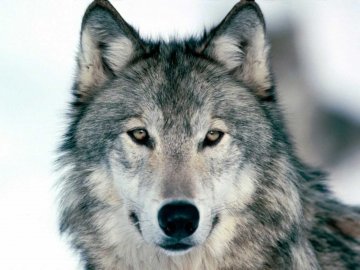Wolf Facts
 1.There are seven species of wolves. They include the Gray, Arctic, Eastern, Ethiopian, Indian, Red and Himalayan Wolf.
1.There are seven species of wolves. They include the Gray, Arctic, Eastern, Ethiopian, Indian, Red and Himalayan Wolf.
2. Once two wolves mate, they are together until one of the wolves dies. They generally spend many years together.
3. A female wolf’s gestation period is typically about 65 days. When the pups are born, they generally weight about one pound and they are deaf and blind at first.
4. When a wolf pup is born, their eyes are blue. But they change to yellow by the time they turn eight months old.
5. Young wolves are ready to go hunting with the pack as early as three months old. Generally, they use it as a learning experience and simply observe the process of hunting prey rather than being part of the takedown.
6. In the wild, a wolf’s average life span ranges from 6 to 13 years. When they are in captivity, they can live between 16 and 20 years.
7. Wolves can run as fast as 35 miles per hour for as long as 20-minute time periods. But they typically move at a speed of about 5 miles per hour most of the time.
8. Wolves are generally nocturnal throughout the year except for the winter months. During the colder season, they are often seen roaming around the land during the day.
9. Wolves have extremely powerful jaws. They have the ability to create a crushing pressure of about 1,500 pounds per square inch. That’s twice the pressure that a dog’s jaw creates.
10. Fully grown wolves have a total of 42 teeth in their mouth.
11. Wolves have approximately 200 million scent cells. This gives them the ability to smell other animals from a mile away.
12.A normal wolf pack can range from two wolves up to about 30 wolves.
13. Wolves in Europe and Asia are verifiably more dangerous than wolves in the Americas throughout history. Between 1580 and 1830 in just France alone, there were more than 3,000 incidences of wolf attacks on people.
14. During WWI, soldiers from opposing forces were sometimes forced to work together to keep wolves at bay as they were attracted to the scent of blood around the battlefield.
15.Wolves will eat members of their own pack if they become sick or weak. In cases where a wolf is trapped by a hunter, they are easy prey for other wolves that are looking for a meal.
16. For a hungry wolf, eating 20 pounds of meat at one meal is not unusual at all. To put that into perspective, that would be the equivalent of a human eating 100 burgers.
17. You would not want to have a wolf as a guard dog because they typically hide from unfamiliar people rather than bark at them.
18. When the United States Endangered Species Act was signed into law in 1973, wolves were the first animal to be placed on the list for protection.
19. There are about 60,000 wolves that live on the North American continent. In Europe, there are fewer than 3,000 wolves. Russia has approximately 70,000 wolves.
20. Many wolf hybrids are actually coyotes. These hybrids are typically referred to as coywolves and they are smaller than wolves, but larger than coyotes.
